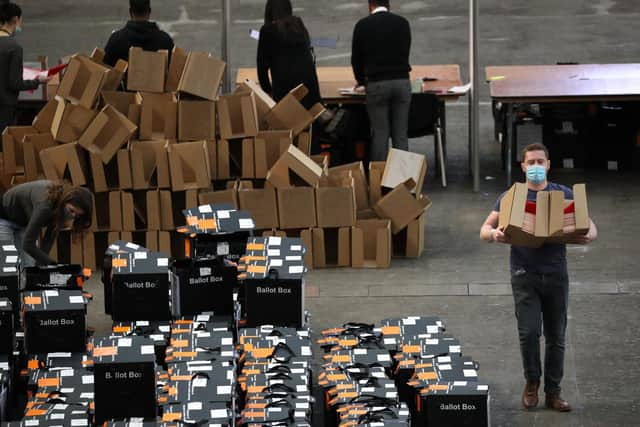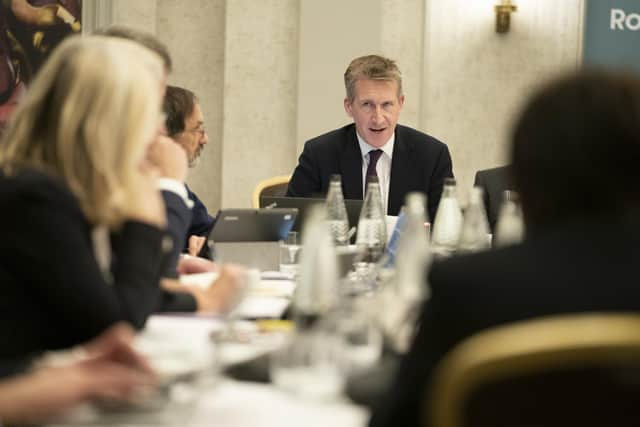Local elections May 2022: What is at stake in my area of Yorkshire?
SOUTH YORKSHIRE
South Yorkshire mayor Dan Jarvis is stepping down after one term to concentrate on his Parliamentary duties.
When Mr Jarvis was elected in 2018 of what was then called the Sheffield City Region, there was no devolution deal in place for the region but that has now been agreed with the Government.


Advertisement
Hide AdAdvertisement
Hide AdIt means voters in the region will be going to the polls for the first time to elect a mayor who will have control over a £1.3bn budget for the next four years, covering spending on issues such as economic development, transport, regeneration, net zero projects and adult education.
With Mr Jarvis securing a comfortable win in 2018, Labour candidate Oliver Coppard is the current favourite to win the election – and become the first Jewish metro mayor in the country in the process.
Mr Coppard, who stood against Nick Clegg in Sheffield Hallam in 2015, refused to stand for Labour under Jeremy Corbyn due to the party’s approach to antisemitism at the time.
He is up against Conservative Clive Watkinson, Liberal Democrat Joe Otten, the Yorkshire Party’s Simon Biltcliffe, Social Democratic Party candidate David Bettney and Bex Whyman, the Green Party candidate and the only woman standing in the mayoral race.


Advertisement
Hide AdAdvertisement
Hide AdIn Sheffield, 28 out of the 84 seats of the council are up for election in a vote that could result in a change of power.
Labour lost overall control of the council last year and is now in a power-sharing agreement with the Greens.
Labour currently has 40 councillors, meaning it needs to win five more seats to regain overall control. Current leader Terry Fox is among those standing for re-election.
The Greens have 13 councillors while the Liberal Democrats, who are the official opposition, have 29, with a single Conservative and one independent in the city.
Advertisement
Hide AdAdvertisement
Hide AdIn Barnsley, one-third of seats are being re-elected – 21 of the overall 63.
Labour currently holds 49 seats on the council, with the second biggest party being the Liberal Democrats with seven.
Last year, Labour had its majority slightly reduced to 35 seats after losing one of the 21 wards contested then.
NORTH YORKSHIRE
A huge shake-up of the way local government operates in North Yorkshire is to begin in earnest next month.
Advertisement
Hide AdAdvertisement
Hide AdWhile a new unitary authority covering the county and replacing the existing county and district councils does not come into operation until next year, elections are to take place on the basis of the new organisation rather than the current models.
It means that in total 90 councillors will be elected to serve one year on North Yorkshire County Council before transitioning to the new unitary authority for a four-year term.
The current county council is controlled by the Conservatives, with the party holding 54 of the 72 seats.
The restructuring is linked to a devolution deal for North Yorkshire which could get millions of pounds in funding, more decision-making powers and an elected mayor by 2024.
Advertisement
Hide AdAdvertisement
Hide AdPaul Shevlin, chief executive of Craven District Council – one of those being disbanded – has described this year’s vote as “the most important election in North Yorkshire since the last local government reorganisation in 1974”.
Election documents reveal there will be 67 Labour, 48 Green, 46 Liberal Democrat and 46 Independent candidates. Other groups represented at the election include Reform UK, Whitby Area Independents, SDP, Liberal and the Yorkshire Party.
The election will see battles for 21 seats in Harrogate borough, seven seats in Richmondshire, eight seats in Ryedale, 13 seats in Selby district, nine seats in Craven, 17 seats in Scarborough borough and 14 seats in Hambleton.
Among the most high-profile candidates is Lady Masham Felicity Cunliffe-Lister, who runs the Swinton Estate, which features a castle hotel, cookery school and glamping site.
Advertisement
Hide AdAdvertisement
Hide AdIn one of the few all-female contests of the election, Lady Masham, standing as an Independent, will face competition for the Masham and Fountains division from Conservative Margaret Atkinson and Liberal Democrat Judith Hooper.
Battling Conservative Thomas Averre and Liberal Democrat Tom Cavell-Taylor in the Ripon Minster and Moorside division will be Independent Andrew Williams, the youngest ever mayor of Ripon who was convicted of pocketing the city council’s ice cream takings at an event to mark the Queen’s Diamond Jubilee in 2012.
Meanwhile, former Richmondshire councillor Jane Parlour, who lost her seat in 2015 following a street fight, will contest the North Richmondshire division for the Liberal Democrats against Conservative and fellow farmer Angus Thompson.
WEST YORKSHIRE
One-third of the 99 seats on Leeds Council are up for election this year, with Labour fighting to retain overall control.
Advertisement
Hide AdAdvertisement
Hide AdThe party currently has 52 seats, with 47 held by other parties and two independents.
The second-largest party is the Conservatives with 23 seats.
It is a similar scenario in Bradford, where 30 out of 90 seats are being contested.
Labour currently hold control, with 51 seats and the Conservatives in second place with 25.
Advertisement
Hide AdAdvertisement
Hide AdNeighbourhood Plan referendums will also be held on the same day as the local election for voters in Ilkley and Oxenhope as they are asked whether they back the plans being used to inform future planning decisions in their areas.
A total of 21 seats are up for grabs in Wakefield – one-third of the overall total.
The council is currently held by Labour, which has 43 of the region’s 63 seats. The Conservatives have 17, the Liberal Democrats two and there is one independent.
Labour will be hoping to win back control of Kirklees Council, needing just a two-seat swing.
Advertisement
Hide AdAdvertisement
Hide AdThe council is currently under no overall control with 23 of the council’s 69 seats up for re-election.
Currently, Labour hold 33 seats, the Conservatives have 19, the Liberal Democrats have nine seats and the Greens and Holme Valley Independents three seats each, with two other independents.
Of the 23 seats up for election this year, Labour hold 11, the Conservatives six, the Lib Dems four, the Holme Valley Independents one and the Greens one.
Labour lost control of the council in November 2020 after three councillors quit the party in protest at the party’s national treatment of Jeremy Corbyn.
EAST YORKSHIRE
Advertisement
Hide AdAdvertisement
Hide AdThe Liberal Democrats have their eyes on Hull Council, with party leader Sir Ed Davey saying in March he believes there is a “real chance” they could take control of the council from Labour.
A total of 19 seats out of the overall 57 are up for election.
Labour currently narrowly hold control of the council with 29 seats, but the Liberal Democrats have 26 – meaning only a relatively small swing is needed for a change in power.
What is happening nationally?
Contests are taking place on May 5 in each of the four UK nations, with every council seat in Scotland, Wales, London and many parts of England up for grabs, along with the election of a new Northern Ireland assembly.
Advertisement
Hide AdAdvertisement
Hide AdMost of the seats up for election on May 5 were last contested in 2018, when the UK was still in the European Union, the prime minister was Theresa May, Labour was led by Jeremy Corbyn and the Liberal Democrat leader was Sir Vince Cable.
The political landscape of the UK has undergone huge changes in the past four years.
Yet many of the issues that can decide local elections remain the same, such as when bins are collected, the state of neighbourhood parks and pavements and access to libraries and hospitals.
This year’s elections are also likely to be a verdict on the main party leaders and their handling of such national issues as Covid-19 and the cost of living.
Advertisement
Hide AdAdvertisement
Hide AdIt will be the first big electoral test for Prime Minister Boris Johnson since the Partygate scandal.
Labour leader Sir Keir Starmer and Lib Dem leader Sir Ed Davey will be judged on whether their parties are able to make gains at the expense of the Conservatives.
In Scotland and Wales, the SNP and Plaid Cymru will want to hold their ground in the face of challenges from the UK-wide parties.
And across the country, smaller groups such as the Greens, residents’ associations and independents will hope to cause surprises and upsets.
Advertisement
Hide AdAdvertisement
Hide AdScotland’s First Minister Nicola Sturgeon said the local elections were an opportunity to “send a message” to Boris Johnson as she launched the SNP’s campaign bus in Dundee.
The yellow bus, which bears text reading “Send Boris a message, ease the squeeze”, will tour Scotland in the 21 days ahead of the elections on May 5.
Meanwhile, at the launch of his party’s election manifesto in Glasgow, the Scottish Tories’ leader Douglas Ross said he was still open to dealing with Labour “to lock the SNP out of power”.
Scottish Labour leader Anas Sarwar has repeatedly ruled out the possibility of coalitions at a local level.
Advertisement
Hide AdAdvertisement
Hide AdSupport The Yorkshire Post and become a subscriber today. Your subscription will help us to continue to bring quality news to the people of Yorkshire. In return, you'll see fewer ads on site, get free access to our app and receive exclusive members-only offers. Click here to subscribe.